In this article, we’ll look at the following parasitic plant examples and comprehensive explanations, and some reference plant images to help you better understand the topic.
Parasitic plant examples include all angiosperms that are incapable to perform photosynthesis to obtain their nutrients, unlike autotrophs.
When a plant is incapable of synthesizing its own nutrients through photosynthesis, it becomes a parasitic plant, relying on other live plants in its surroundings (as a host plant) to obtain part or all of its nutrition.
Parasitic plants lack chlorophyll on their leaves, so they cannot perform photosynthesis. And thus, parasitic plants are unable to supply nutrition for themselves, necessitating the assistance of the host plant.
The parasitic plant does not contribute to the host’s benefit or have a symbiotic relationship with it but rather takes advantage of the host. The parasitic plant causes severe damage to the host while stealing its nutrients and water in rare situations.
A sole distinguishing feature of the parasitic plant is its ‘Haustorium‘. A parasitic plant’s haustorium is a dedicated structure that enters the host and produces a vascular connection between the plants.
Since all parasitic plants are angiosperms, not all parasitic plants are angiosperms. On the other hand, certain aquatic plants are parasitic and are designated as Benthic, which means they are immobile or tied to some other body and expand with its support. In temperate instead of tropical waters, aquatic parasites constitute a large share of the oceanic flora.
Sometimes few parasitic plants are harmful to their ecosystems, while others have favorable impacts on the ecosystem.
Parasitic Plant Example
So, here are some parasitic plants examples with a brief description of them:
1. Orobanche Ramosa
As it belongs to a broomrape species, Orobanche Ramosa is also known as Hemp or Branched Broomrape. It is a parasitic plant that feeds on the nutrients from the roots of other living plants in its surroundings. It can’t make its own nourishment since its leaves lack chlorophyll, making photosynthesis impossible.
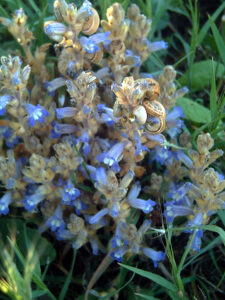
2. Viscum Album
As it is a species of Mistletoe, Viscum album is sometimes known as European mistletoe or just mistletoe. It is a hemiparasite evergreen shrub, which means it lives as a parasitic in natural order but is still photosynthetic to some extent. It spreads and grows on the trunks and branches of the host tree or plant. It may just get mineral nutrients from the growth medium(host plant), or it may also get a portion of its organic nutrients.
3. Orobanche Minor
Orobanche minor is, however, known as Hellroot, clover broomrape, and other names. Orobanche is a genus of parasitic plants like Orobanche minor. It is a holoparasitic flowering plant, which means it gets all of its carbon content from its host plant. Since it lacks chlorophyll, it is frequently found in colors other than green.

4. Stinking Corpse Lily
Rafflesia arnoldii, or Giant Padma, is another name for Stinking Corpse Lily. It belongs to the Rafflesia genus. It is a parasitic plant that gets its nutrition and maintenance from the host plant.
It is a vascular plant, meaning it has no visible leaves, roots, or stems, and it excludes chlorophyll pigments, preventing it from performing photosynthesis. Until now, the corpse flower is the world’s largest single flower.
5. Yellow Rattle
Rhinanthus minor (yellow rattle) is a species of Rhinanthus. It belongs to the family Orobanchaceae or broomrape. It’s a facultative root hemiparasite plant, which means it can get adequate nutrients and water from the host plant; otherwise, it can also get some of its organic nutrients.
Although, in some cases, if the conditions are appropriate, it may be able to prepare its own nutrition through photosynthesis.
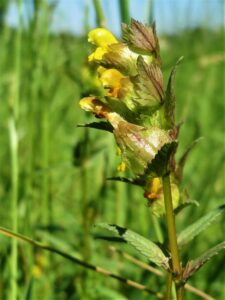
6. Cuscuta Campestris
Golden dodder, yellow dodder, large-seeded alfalfa dodder, and a few other names have been given to Cuscuta campestris. It was previously categorized as a member of the Cuscutaceae family. It is a parasitic plant that lacks chlorophyll and hence cannot generate its own food through photosynthesis, so it must rely on its host plant for nutrition.

7. Phelipanche Aegyptiaca
The Egyptian broomrape is also known as Orobanche or Phelipanche aegyptiaca. It is a part of the Orobanchaceae family. Most physical and herbicidal procedures are ineffective because of the intimate connection between the parasite and the host plant. Since the parasite’s physical contact happens below ground with the haustoria, it’s critical to double-check that the plant’s roots are attached to the weed.
8. Cuscuta Australis
Australian dodder is the scientific name for Cuscuta australis. It’s a parasitic herbaceous plant and climber of the Convolvulaceae family.
For nourishment, it is connected with many different plants. It interacts with both native and exotic plants since it is a parasite. It synchronizes its flowering to that of its plant host to enhance seed output by detecting a transmitting protein in the host.
9. Orobanche cernua
Orobanche cernua is regarded as an obligatory parasite because it cannot accomplish its life cycle without the support of a host. For the host plant, it becomes an active absorbent. It is a non-photosynthetic parasite that produces leafless flowering that is chlorophyll-free.
10. Cassytha filiformis
Cassytha filiformis is sometimes known as love vine. It is an obligatory parasitic vine in the Lauraceae family. Its nourishment and survival are entirely dependent on the host plant. Its haustoria serve as a pathway for nutrient importation from the host plants.
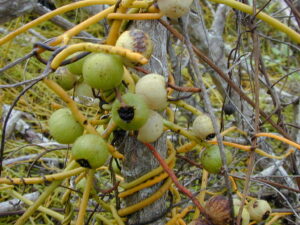
11. Nuytsia Floribunda
The Loranthaceae family also includes Nuytsia Floribunda. It is a hemiparasitic tree that, in favorable conditions, stays photosynthetic sometimes. It relies on its host plant for mineral and water nutrients and a portion of its organic nutrients.
The haustoria that grow from Nuytsia Floribunda’s roots hook to the roots of several surrounding plants and collect nutrients and water from them.
12. Greater Dodder
Cuscuta europaea is another name for Greater Dodder. It is a part of the Convolvulaceae family. It’s a parasitic herbaceous plant. It gets its food and nourishment from the host plant. It has a meaningful existence in the environment and is used to treat hepatic disorders.
13. Cuscuta Epithymum
Hellweed, dodder, or lesser dodder are all names for Cuscuta Epithymum. It belongs to the Convolvulaceae or Cuscutaceae family of parasitic plants. It is non-photosynthetic since its plant body is red-pigmented and lacks chlorophyll pigments in contrast.
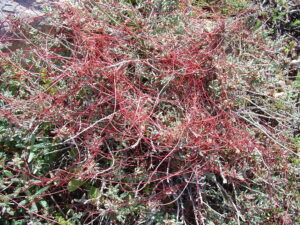
14. Scaldweed
Scaldweed is the scientific name for Cuscuta gronovii. Cuscuta gronovii is a species of the Convolvuaceae family. It’s a yellow-colored vine that grows on other host plants like a parasite. In a parasitic relationship, it infects the host plants of its surrounding.
On the other hand, this species has a modest quantity of chlorophyll. It is insufficient to sustain the plant alone by photosynthesis.
15. Hydnoroideae
The Hydnoroideae is a parasitic flowering plant that belongs to the Aristolochiaceae family. The absence of leaves in Hydnoroideae, even in modified forms like scales, is most commonly the reason for lacking chlorophyll.
As a result, it is incapable of performing photosynthesis. The flowers of hydnoroideae either grow above or below ground. It is one of the strangest plants on the planet.
16. Beechdrops
The Beechdrops plant is otherwise known as Epifagus Virginiana. It belongs to the Orobanchaceae family. It’s an obligatory parasitic plant, which means it can’t complete its life span without the help of a host. It feeds on the roots of the host plant and grows there.
Since beechdrops do not photosynthesize their own nutrients, the parasite produces a haustorium structure that penetrates beech roots to absorb nutrition from its host.
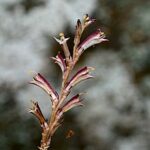
17. Viscum Cruciatum
Red-berry mistletoe is the common name for Viscum cruciatum. It is a mistletoe species belonging to the Santalaceae family. A parasitic plant acts on a root, producing haustorium from the flattened portion of the radicle’s base, which enters the bark straight and reaches the cambium and phloem.
The network of transverse strands and circumferential sinkers arises from this haustorium, which draws nutrients from the plant host for parasite development.
18. Chaparral Dodder
Chaparral dodder is another name for Cuscuta California, and it is a species of dodder. It’s a parasitic plant that gets adequate nutrition via haustorium from the plant host, although it’s unlikely that it destroys the host plant.
19. Cuscuta Approximata
Cuscuta approximata is also commonly known as alfalfa dodder, and it is a species of dodder. It’s a parasitic vine plant that climbs up other host plants and feeds on them simply through a haustorium. Its stems get attached to the host plant for its nutrients intake.

20. One-flowered Broomrape
One-flowered broomrape is Orobanche uniflora, ghost pipe, or one-flowered cancer root. It’s a parasitic herbaceous annual plant that feeds on the nutrients of other host plants via their root systems. The plant does not generate any green components required for photosynthesis since it lacks chlorophyll.
21. Red Rattle
Red-Rattle is a Pedicularis palustris, also known as marsh lousewort. It belongs to the Orobanchaceae family of plants. A parasitic plant feeds on the host plant’s photosynthesis nutrients. On the other hand, the parasitic plant uses those energy reserves to grow and develop.
22. Rafflesia Manillana
Rafflesia manillana is a parasitic plant that feeds on other plants. It is a member of the Rafflesiaceae family. The haustoria give them the capacity to take nutrients and water from the host plant because it has no apparent leaves or stems.
23. Wyoming Indian Paintbrush
Castilleja linariifolia, sometimes known as Wyoming Indian Paintbrush, is a member of the Orobanchaceae family. It is a perennial parasitic plant that develops close to its host plant, which assists the parasite plants in obtaining all of their nutrients.
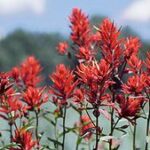
24. Cuscuta Salina
Cuscuta salina is a dodder species that belongs to the Convolvulaceae family. It is a parasitic plant that has lost all photosynthetic potential due to the lack of green-colored leaves and stems. Therefore, it absorbs water and nutrients from host plants through modified structures known as haustoria.
25. Orobanche Lutea
Orobanche Lutea is also known as Yellow Broomrape. It is a holoparasitic plant, which means it gets all of its carbon content from the hostplant. Holoparasites are generally in different colors other than greenish leaves since they lack chlorophyll.
26. Rafflesia Mira
Rafflesia Mira is a member of the Rafflesiaceae family and belongs to the genus Rafflesia. It’s a parasitic plant with no stems, roots, leaves, or photosynthetic tissue, which is essential to make its own nutrient. They get all of their energy and nutrients from their host plants. But it only emerges as blooms or flowers from the roots or invisible lower stems of the host plants.
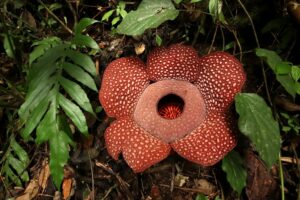
Also Read:
- Examples of monocot
- Monounsaturated fat
- Photosynthesis reaction
- Light independent reaction example
- Nucleotides in dna structure
- Do chloroplasts have ribosomes
- Do bacteria have flagella
- Heterotroph
- Polymerase chain reaction
- Chemiosmosis in mitochondria
Hey! I’m Roshny Batu. I got a Bachelor of Science degree in Botany. In the domain of academic writing, I consider myself fortunate to be a part of the Lambdageeks family as an SME in Bio-Technology. Apart from that, I love designing interiors, painting, and mastering makeup artist skills.